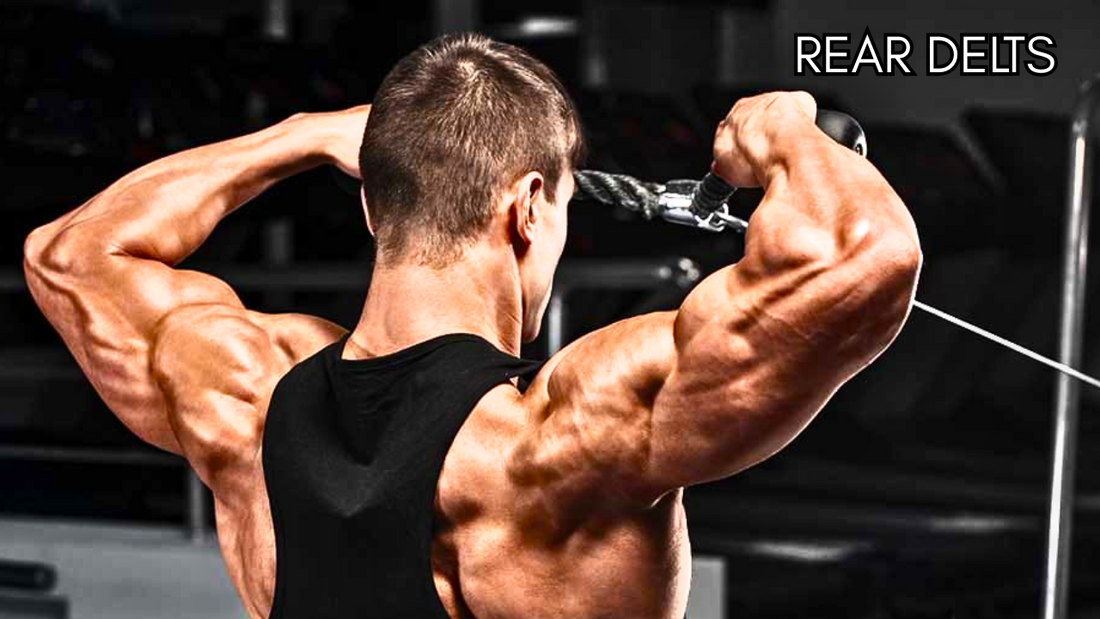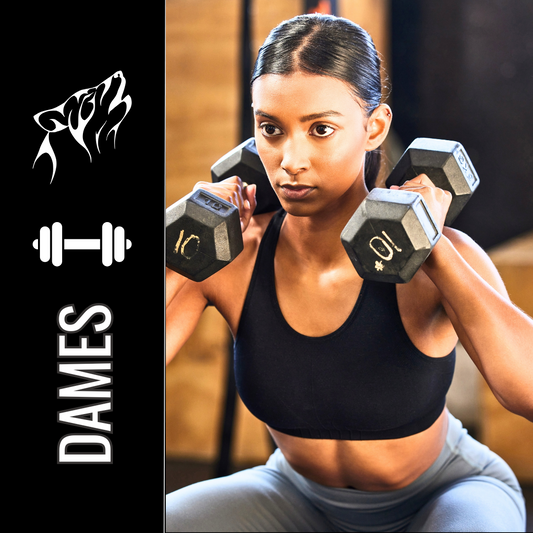
Best 4 Exercises for Rear Delts with Dumbbells and Cable!
Share
Looking to build bigger rear delts for rounder, more defined shoulders? I’ll walk you through the 4 best exercises using dumbbells and cables. Each exercise comes with an instructional GIF and clear, easy-to-follow explanations, so even if you're a complete beginner, you'll have everything you need to get started. After the exercises, I'll also share some bonus tips on how to stimulate rear delt growth, even when you're training other muscle groups.
1. Dumbbell Rear Delt Raise

Stand with your feet hip-width apart, holding a dumbbell in each hand with a neutral grip (palms facing each other). Hinge at the hips and slightly bend your knees, allowing your torso to lean forward until it's nearly parallel to the ground. Keep your back flat and your core engaged. With a slight bend in your elbows, raise the dumbbells out to your sides in a wide arc, squeezing your shoulder blades together at the top of the movement. Pause briefly, then lower the weights in a controlled motion. Focus on moving through the rear delts, not the traps, and avoid using momentum. This isolation exercise directly targets the rear deltoids, helping to build balance and definition in the shoulders.
YouTube Short: https://www.youtube.com/shorts/APGkl74ovWs
2. Incline Reverse Flyes

Set an incline bench at about a 30–45 degree angle and lie chest-down with a dumbbell in each hand, arms hanging straight down. With a neutral grip, keep a slight bend in your elbows as you raise the dumbbells out to your sides in a reverse fly motion. Squeeze your shoulder blades together at the top, then slowly lower the weights back down. Keep your head in a neutral position and avoid arching your back. This version minimizes momentum and increases isolation on the rear delts, making it a great variation for focused shoulder work.
YouTube Short: https://www.youtube.com/shorts/Y2BOqe3W_4I
3. Rear Delt Cable Raise

Set the cable pulleys at the lowest setting and attach single handles. Stand in the center of a cable machine and grab the left handle with your right hand and the right handle with your left hand, creating a cross in front of your body. With a slight forward lean and a soft bend in your elbows, pull the cables out and back in a wide arc until your hands are level with your shoulders. Pause and squeeze your rear delts, then return to the start position with control. Avoid using your traps to lift the weight. This variation keeps consistent tension on the rear delts through the full range of motion.
YouTube Short: https://www.youtube.com/shorts/fGvidfsPhYo
4. Cable Face Pull

Attach a rope to the upper pulley of a cable machine and stand facing the machine. Grip the rope with both hands using an overhand grip, and take a step back to create tension in the cable. Pull the rope towards your face while flaring your elbows out and keeping your upper arms parallel to the ground. Focus on squeezing your rear delts and upper traps at the peak contraction. Slowly return to the starting position without letting the weight stack slam. This excellent posture-improving exercise targets the rear delts, traps, and external rotators, making it a great addition to any balanced shoulder routine.
YouTube Short: https://www.youtube.com/shorts/-XomeScMc88
1. Which back exercises also train the rear delts?
Although rear delts (posterior deltoids) are shoulder muscles, they’re often indirectly activated during many compound back exercises. Movements that involve horizontal pulling, such as Barbell Rows, Seated Cable Rows and T-bar rows engage the rear delts along with the upper back muscles. In particular, when you pull with your elbows flared outward and lead the movement with your rear shoulders rather than your lats, the rear delts become more active.

Exercises like Reverse flyes on a cable or machine and Rear delt rows (a row with a high elbow path) are technically back-and-shoulder hybrids and are often included in upper back workouts. Even Pull-Ups and Lat Pulldowns, while mainly lat-focused, recruit the rear delts to a small degree, especially when you maintain good posture and bring the elbows behind the body.
So, if you’re already doing a solid back workout with a variety of pulling motions, chances are your rear delts are getting some stimulation. However, if you want optimal development, especially for aesthetics and balance, it's still important to train them directly with focused rear delt movements at least once a week.
2. Why is it important not to skip rear delt training?
Many lifters unintentionally neglect the rear delts because they’re not as visible as the front (anterior) or side (lateral) deltoids. This creates an imbalance where the front shoulders become dominant while the rear delts stay underdeveloped. As a result, the shoulders appear less “3D” and rounded, and in some cases, this imbalance can lead to poor posture or even shoulder discomfort during pressing movements.
Training the rear delts helps create a fuller, more symmetrical shoulder look, which is crucial for bodybuilding, aesthetics, and balanced strength. If you only focus on the front and side delts (as many do with lots of overhead pressing and front raises), your physique can look disproportionate from the side and the back.
Furthermore, weak rear delts can impact performance and shoulder stability in compound lifts such as Bench Press, Overhead Press, and Deadlifts. Strong rear delts help keep the shoulders pulled back and stabilized, which is essential for both lifting heavier weights and preventing injury. In short, skipping rear delt work is like building a house without reinforcing the back wall, it leaves your progress unstable.
3. What are the benefits of having strong, muscular rear delts?
Strong rear delts contribute to better posture, shoulder stability, and improved performance in major compound exercises. For example, in Bench Pressing, powerful rear delts help retract and stabilize your shoulder blades, giving you a more solid pressing base. In Overhead Pressing and Pulling Movements like Deadlifts or Rows, rear delts assist in controlling the bar and protecting the shoulder joint.
From an aesthetic perspective, well-developed rear delts are the final touch for broad, round, and 3D-looking shoulders. When viewed from the side or back, muscular rear delts create that coveted “capped” shoulder look, giving your upper body a more complete and balanced appearance. They also help enhance the V-taper by adding visual width to the upper back and shoulders.

The good news is: you don’t need to spend hours training them. Just 2 to 3 focused rear delt exercises per week, using dumbbells, cables, or machines is enough to see progress over time. Include movements like Rear Delt Raises, Face Pulls, and Reverse Flyes, ideally in higher rep ranges (12–20 reps), and stay consistent. It’s a small investment with big rewards in both performance and appearance.
You can watch our shoulder exercise playlist below. This video features all the shoulder exercises we recorded at the gym to help beginners learn proper form.
Author:
Badreddine Boutaybi

























































